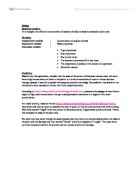On the other hand, if the concentration of the solution is higher than the concentration within the potato cell, then water from the potato cell will move out into the solution, through the semi-permeable membrane by osmosis. This means that each cell of the potato chip will decrease in size and mass as water leaves the cell. If the difference between the two concentrations is large enough, then the cell can lose so much water that the cell membrane is pulled away from the cell wall. The cell is then said to be plasmolysed and would look like the cell in Fig.2. A solution which brings about such changes is known as hyper-osmotic solution. Each cell becomes flaccid and the chip as a whole shows the net result of these changes.
In some cases, the concentration of solution outside a cell is the same as the concentration of solution inside the cell. In such cases there is no concentration gradient, so there is no movement of water across the cell membrane. Therefore, there is no change in mass or size of the cell. In this case the solutions are said to be iso-osmotic.
Diagram:
Figure 1. A turgid cell. Figure 2. A plasmolysed cell
Sources:-
)
Method:
- Cut a potato into 5 chips.
- Weigh each potato chip and measure the length of each potato chip.
- Then immerse each potato chip in five different solutions: distilled water, 0.1M NaCl, 0.2M NaCl, 0.3M NaCl and 0.4M NaCl.
- Leave the chips in the solutions for a day.
- The next day weigh the new mass of each chip and measure the new length of each chip.
- Record the readings.
- If possible perform about 3 trials of this experiment to get readings and observations of maximum accuracy.
Results:
Table 1: Masses and lengths of potato chips before Trial 1;-
Table 2: Masses and lengths of potato chips in Trial 1:-
* This result appears to be anomalous
Table 3: Percentage change in mass and length of potato chips in Trail 1:-
*This result appears to be anomalous
Table 4: Results for Trial 2:-
* this result appears to be anomalous.
Table 5: Results for Trial 3.
*This result appears to be anomalous.
Observation:
Distilled water:-
The potato chip that was immersed in distilled water grew longer and also increased in mass. It was also very rigid and hard.
0.1M NaCl solution:-
The potato chip that was immersed in 0.1M NaCl solution did not increase in length but it did increased in mass. It was relatively hard and rigid but not as much so as the chip immersed in distilled water.
0.2M NaCl solution:-
The potato chip that was immersed in 0.2M NaCl solution decreased in length but it increased in mass. It was not as hard or inflexible as the potato chip in 0.1M solution.
0.3M NaCl solution:-
The potato chip that was immersed in 0.3 NaCl solution decreased in length and in mass. It was soft and quite flexible.
0.4M NaCl solution:-
The potato chip that was immersed in 0.4M NaCl solution decreased in length and mass. It was very soft and very flexible.
Analysis:
Thus, we can deduce that the potato chips immersed in distilled water became longer and increased in mass because the potato cells absorbed water from their surroundings by osmosis as distilled water is a highly hypo-osmotic liquid.
The next potato chip is immersed in a solution of 0.1M of NaCl. Thus, as there are some solute molecules in the water, it is a less hypo-osmotic solution. Thus the potato chip will not become as turgid as the one immersed in distilled water. Somewhere between the concentration of 0.1M and 0.2M of NaCl it can be deduced that the solutions will become iso-osmotic, i.e., the concentration of the solution within the cell and outside the cell will be the same and so there will be no change in mass of length of the potato chip.
In this way as the concentration of the solution increases it becomes less and less hypo-osmotic, then it becomes iso-osmotic, and eventually (at 0.3M NaCl), the solution becomes hyper-osmotic. Thus, the cells of the potato chips immersed in the solutions of concentrations 0.3M and 0.4M NaCl lose water to their surroundings and become plasmolysed.
Conclusion:
From the tables, observations and the analysis, these are the conclusions that can be reached:-
Table 6:Conclusions:-
Thus, from Table 6 we can assume that the concentration of the solution in the cell is somewhere between 0.1M and 0.2M
Evaluation:
Despite taking several measures to prevent errors from occurring, a certain number of errors are unavoidable. These are mainly random errors which are caused by mistakes made while handling or reading equipment. These are probably the main reasons for the anomalies which have been discussed
Special care was taken to ensure that the experiment was a fair test. All the chips were cut from the same potato, therefore eliminating any differences in absorbency. The flexibility of chips was tested after they had been weighed and measured so that it would not matter if pieces of the chips broke off since they had already been weighed and measured. To improve this experiment a wider range of concentrated solutions could be used to produce more varied results that would highlight, more clearly and accurately, the concentration of the solution inside potato cells.
Overall, this experiment was quite accurate and successful in investigating the process of osmosis and concluding that the concentration of solution inside a potato cell is somewhere between 0.1M and 0.2M.








